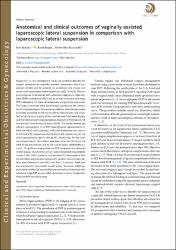| dc.contributor.author | Akbaba, Eren | |
| dc.contributor.author | Sezgin, Burak | |
| dc.contributor.author | Sivaslıoğlu, Ahmet Akın | |
| dc.date.accessioned | 2021-09-09T07:10:48Z | |
| dc.date.available | 2021-09-09T07:10:48Z | |
| dc.date.issued | 2021 | en_US |
| dc.identifier.citation | Eren Akbaba, Burak Sezgin, Ahmet Akın Sivaslıoğlu. Anatomical and clinical outcomes of vaginally assisted laparoscopiclateral suspension in comparison with laparoscopic lateral suspension. Clinical and Experimental Obstetrics & Gynecology, 2021, 48(4): 935-941. | en_US |
| dc.identifier.uri | https://doi.org/10.31083/j.ceog4804148 | |
| dc.identifier.uri | https://hdl.handle.net/20.500.12809/9526 | |
| dc.description.abstract | Background: In this retrospective study, we aimed to describe the surgical procedure for vaginally assisted laparoscopic lateral suspension (VALLS) and to compare its anatomical and clinical outcomes with laparoscopic lateral suspension (LLS). Methods: The surgical outcomes of 26 women with advanced-stage pelvic organ prolapse (POP) undergoing VALLS and 35 women with advanced-stage POP undergoing LLS were retrospectively analysed and compared. The surgical outcomes were documented according to the International Urogynecological Association guidelines. Complications were evaluated according to the Clavien-Dindo classification and classified using the joint project of the International Continence Society and the International Urogynecological Association Prosthesis/Graft Complication Classification System. Results: The results showed significant improvement in all POP Quantification measurements in both the VALLS and LLS groups, with overall objective cure rates of 88.4% and 80%, respectively (96.1% and 91.4%, respectively, for the apical compartment; 96.1% and 85.7%, respectively, for the anterior compartment). The median operation times for VALLS and LLS were 77 [66-90] minutes and 99 [82-125] minutes, respectively (p = 0.001). A significant improvement in POP symptoms was observed in both groups. Occult stress urinary incontinence (SUI) was detected in two (7.6%) VALLS patients, and de novo SUI developed in four (15.3%) VALLS patients post-operatively. Anterior compartment defects were detected in one VALLS and five LLS patients. Mesh erosion was found in one patient in each group. Discussion: VALLS appears to be an effective and reliable surgical method for patients with advanced-stage POP and can offer advantages in terms of operation time and POP recurrence rates | en_US |
| dc.item-language.iso | eng | en_US |
| dc.publisher | IMR Press Limited | en_US |
| dc.relation.isversionof | 10.31083/j.ceog4804148 | en_US |
| dc.item-rights | info:eu-repo/semantics/openAccess | en_US |
| dc.subject | Laparoscopic lateral suspension | en_US |
| dc.subject | Minimally invasive surgery | en_US |
| dc.subject | Pelvic organ prolapse | en_US |
| dc.subject | POP surgery | en_US |
| dc.subject | Vaginally assisted laparoscopic lateral suspension | en_US |
| dc.title | Anatomical and clinical outcomes of vaginally assisted laparoscopic lateral suspension in comparison with laparoscopic lateral suspension | en_US |
| dc.item-type | article | en_US |
| dc.contributor.department | MÜ, Tıp Fakültesi, Cerrahi Tıp Bilimleri Bölümü | en_US |
| dc.contributor.authorID | 0000-0002-4724-0779 | en_US |
| dc.contributor.institutionauthor | Akbaba, Eren | |
| dc.contributor.institutionauthor | Sezgin, Burak | |
| dc.contributor.institutionauthor | Sivaslıoğlu, Ahmet Akın | |
| dc.identifier.volume | 48 | en_US |
| dc.identifier.issue | 4 | en_US |
| dc.identifier.startpage | 935 | en_US |
| dc.identifier.endpage | 941 | en_US |
| dc.relation.journal | Clinical and Experimental Obstetrics and Gynecology | en_US |
| dc.relation.publicationcategory | Makale - Uluslararası Hakemli Dergi - Kurum Öğretim Elemanı | en_US |


















